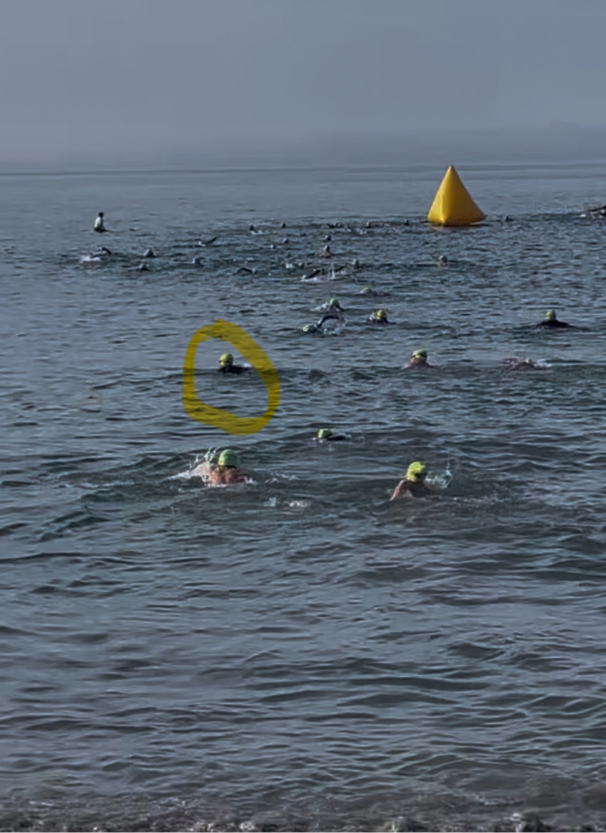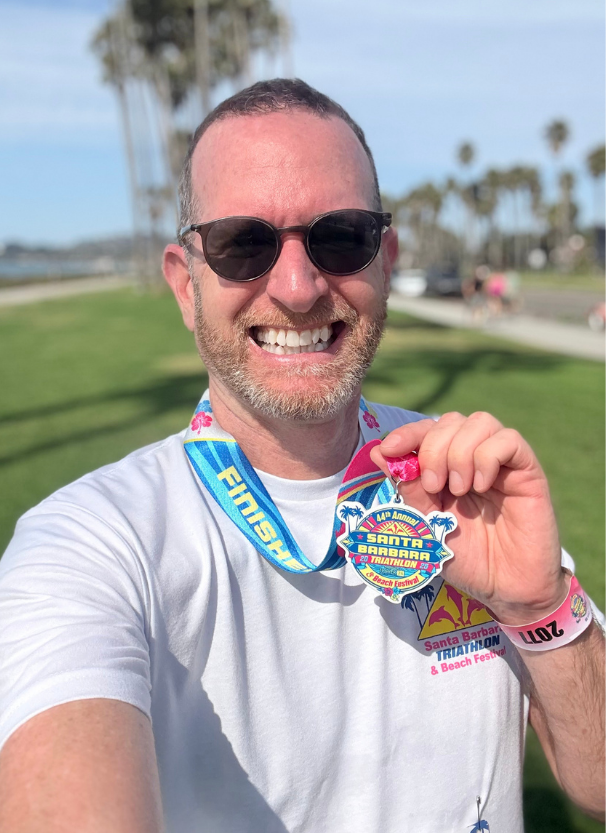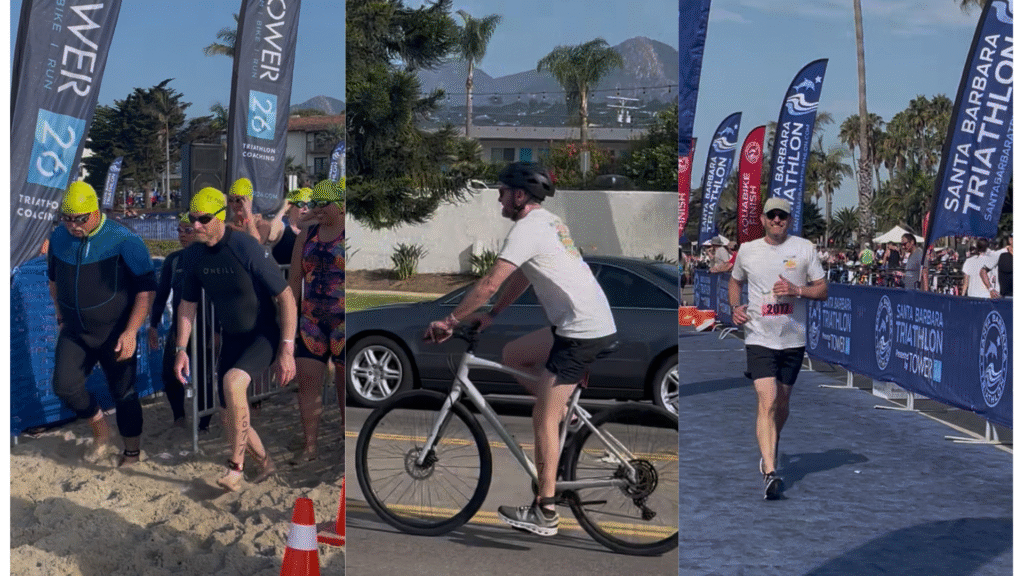Years of yoga practice was what got me through.
(Photo: Courtesy Jivana Heyman)
Updated October 13, 2025 12:40PM
Late this summer, I found myself swimming 500 yards in the open ocean, gasping for air with the pounding of my heart amplified by the relentless thrashing of the water, wondering how I got myself into this situation.
All of a sudden my awareness shifted, as it often does when I meditate. My mind slowed down and I could observe the reality of where I was without the overwhelming fear. That moment of perspective helped me reconnect with the sensation of being in my body, and the rhythmic movement of swimming. I was able to lengthen my exhalations and my body responded by slowing my breathing. That allowed me to keep going and I thought, “Maybe I can do this.”
That was the exact thought that had led me to sign up for my first sprint triathlon at the age of 58—and landed me in this moment.
Starting Slowly
I never considered myself athletic. The most exercise I had practiced was gentle asana (yoga postures) for the last 35 years. My focus has always been more on the subtle practices of pranayama (breathwork), meditation, and yoga philosophy.
My interest in exercise started innocently enough a few years ago with beach walks. Each morning, I noticed a man who was considerably older than me, probably in his early 80s, jogging the entire length of the beach. I was impressed. The mere idea of running scared me, as I’d had my share of back issues and believed I was too old to push myself like that. But his grit inspired me. I recall thinking, “Maybe I could do that?”
My walks slowly turned into hesitant jogs. My body protested at first, although the sensations from running felt like exploring a new asana, which intrigued me. Even when I became sore, I felt a new strength that I had either never experienced or forgotten.
Running also felt like an extension of my breathwork practice. When I was running, I was so aware of my breath and how my body was constantly trying to deepen it. It felt like my body was practicing pranayama instinctively based on its need for more oxygen.
Around the same time, I started biking more. Eventually, I got rid of my car as it would support my physical wellness and support the environment. I also added weightlifting to my everyday workouts based on research about how we slowly lose muscle and bone mass as we age, potentially up to two percent each year after the age of 35.
The Power of Maybe
One day last August, I happened to be on the beach as the Santa Barbara Triathlon was taking place. I watched in awe as athletes competed in the swim, bike, and run. I stood in the sand and watched the triathletes exiting the water as they completed the swim portion. What surprised me was that they looked like regular people. Like me. They didn’t look like the athletes we see in the media. They were all ages and body types, and their diversity inspired me to think, “Maybe I could do that.”
That “maybe” was more powerful than I realized. Over the years, yoga has shown me that my identity is mutable. I’m not simply my mind and my endless thoughts. I know I’m much more—maybe love, maybe spirit, maybe an athlete. In that moment, I realized that I was limited not only by my perceived physical ability, but by my self-image and my belief that I wasn’t an athlete. In fact, that notion may have been my most limiting factor.
I’ve always been intrigued by the self-inquiry at the heart of Jnana Yoga, the path of wisdom and self-knowledge. This path asks us to question the beliefs that make up our identity by literally asking ourselves the question, “Who am I?” You can try a Jnana Yoga meditation yourself. Sit comfortably, take a few breaths, and repeat the question, “Who am I?” You can also ask any related questions. For example, “Am I my body?” “Am I my thoughts?” “Am I the breath?” “Where do my thoughts come from, and where do they go?” “Who am I?” Then sit for a few minutes in silence and listen for an answer or for whatever comes.
Last June, after sitting with and questioning who I thought I was and working to overcome my fear, I took a leap of faith and signed up for a sprint triathlon, which is about half the Olympic triathlon distance. It consisted of a 500-yard open ocean swim, six-mile bike ride, and two-mile run with timed transitions in between. For a so-called short course, it still seemed daunting for a beginner like me.
I decided that my goal was to complete the triathlon safely by approaching training and the race as a yoga practice. I also realized that although I was a little old to be launching into an endurance sport, my yoga practice would help keep me safe from injury.
Facing My Fears
I spent the next two months focusing on the open water swim, which was the part of the three-part race that felt most overwhelming. I’m an okay swimmer—or so I thought. But swimming in the Pacific Ocean was a different story. There was almost zero visibility under the murky water, it was usually too cold to keep my head in the water for long periods of time, there were lots of waves and random currents, and the thought of sharks sometimes gave me a slight panic.
My fear of sharks wasn’t unfounded. This area is known as a nursery for juvenile Great White Sharks, even though they usually ignore humans. I was told to avoid swimming alone and to stay close to shore, which didn’t make me feel much better. But I decided this was a practice of self-discipline, or tapas, and I committed to swimming in the ocean every other day.
Swimming is also an experience of sensory deprivation or pratyahara. There is only the sound of my breath and the feeling of my body moving through the weight of the water. Sometimes during my beginner triathlon training I felt like the salt water made me buoyant and light, but most of the time I felt like the waves were trying to pull me under.

Breathing during swimming is also backward compared to yoga. I had to learn to inhale through my mouth and exhale bubbles from my nose. Years of pranayama made it even harder for me to give up nasal breathing, but I reminded myself that yoga is also about having a flexible mind, and I appreciated that aspect of the challenge.
In fact, each part of the triathlon—swimming, biking, and running—made different demands on my body and on my breath. Exploring each one as a yoga practice helped me realize that there is still so much for me to learn about my body as I approach my seventh decade.
The long training bike rides and runs felt similar to lingering in challenging standing poses that seem to last forever. Even when it seemed okay in the beginning, there was always that moment when my muscles started to complain and my mind needed to recommit and keep going. That’s where tapas comes in again. I frequently found myself out of breath and already exhausted yet facing a big hill ahead. The thought came back like a mantra, “Maybe I can do that.”
Yoga teacher and triathlete David Lipsius also believes there’s a strong connection between yoga and triathlons. I met Lipsius years ago and we stayed in touch ever since. When I shared my plans for my first triathlon, he told me about his accomplishments related to completing countless triathlons, including six Ironman events. The Ironman consists of a 2.4-mile swim, a 112-mile bike ride, and a 26.2-mile run without so much as a break.
I sought out his advice as my event approached, and he had some words of wisdom for me. “Whether one is staring at the black line at the bottom of a pool for 3000 meters, tucked tight in an aero position riding a century at your very edge, or hammering out a marathon run with only your breath and your pulsing heartbeat for company, triathlon training is a perfect meditation, combining sense withdrawal, one-pointed concentration, and flow state freedom into one spectacular union of mind, body, and spirit,” Lipsius explained. “Both encourage a participant to leave behind ways of being that limit one’s potential; and both teach that the body, breath, and mind are capable of far more than one can imagine.”
His encouragement was another piece of the puzzle. I started to see that this effort wasn’t just about reimagining who I am, building up my physical capacity, and considering it as a powerful practice. His kind words also made me realize the importance of finding a supportive community.
Diving In
When the day came, my mind was more overwhelmed than my body. But I was encouraged by the camaraderie of the other racers. There was a sense that we were there to support each other rather than race against one another. I’ve always found that sense of mutual support in the accessible yoga community, and it was joyful to experience it in a new culture that I had wrongly assumed would be more competitive.
For example, we had to write our race number and age on our upper arms and calves, and people eagerly helped each other with that as they shared nervous laughter before the race started. At one point, I was running behind a woman who seemed much younger than me. She suddenly stopped and seemed to give up, slumping over. I slowed down and said, “If I can do it, you can do it!” She smiled, thanked me, and started running again.
The biggest challenge was the swim—just as I’d expected. The course took us out much farther than I had ever swum and the water was cold, deep, and dark. The middle of the course was when I couldn’t catch my breath and desperately drew on everything I’d previously learned. I slowed my breathing and I managed to repeat the magic words, “Maybe I can do it?” I ended up finishing at a faster pace than I had ever swam during my beginner triathlon training, even though I wasn’t sure I would even reach the beach!
During the bike ride and run, I had to watch my heart rate, which was spiking more than usual from the excitement of the day. I continually tried to slow myself down by remembering my breath and my commitment to finishing safely. Again, my yoga training helped me work on my inner competitive nature and keep my eyes on my own mat, so to speak. To help with that, I tried to celebrate the other athletes as they passed me on the course—especially the older racers whose ages I could see on the backs of their legs—by reveling in their strength and endurance.
Body-Mind Relationship
Throughout the months leading up to the triathlon and since then, I’ve noticed how the relationship between my body and mind has changed. It feels like we have a more fluid and changeable relationship—mind supporting body and body supporting mind. When I felt like I couldn’t breathe during the swim, my meditation practice helped pull my mind back from fear and panic. When my muscles were complaining during the bike ride, I focused on my breath and watched the sensation pass.
In some ways, I can see that it was my triathlon training at work. But I also know that it was the result of hours and hours of asana, pranayama, and meditation coming together and supporting me in the most surprising ways. I don’t think I would have had the courage, or the mental strength, to take on this kind of extreme challenge without my yoga practice.
In the end, I finished sixth out of 14 men in my age group. More importantly, I finished safely—and I learned about myself in the process.
So many times during my training and racing, I found a way to work with my mind to take on new challenges and overcome fear. Yoga showed me the power of letting go of preconceived ideas about who I am and embracing the power of “maybe.” I can see now that these ideas of my abilities not only limit my body and my mind, they limit my ability to imagine what I can accomplish in life. The question I am left with is not “Who am I?” or even “Maybe I can do this?” It’s “What’s next?”



